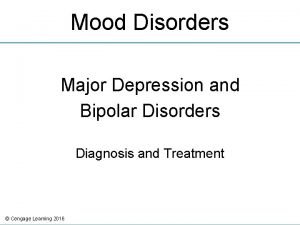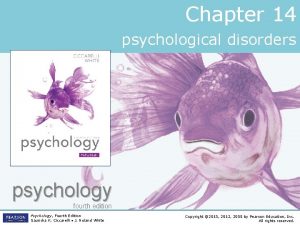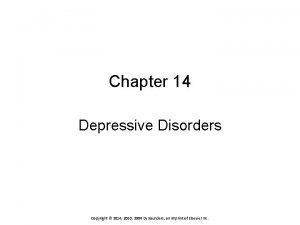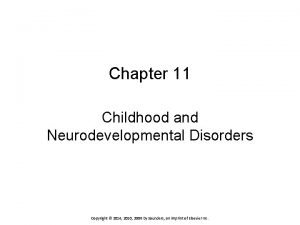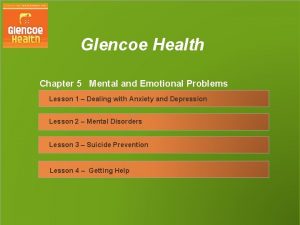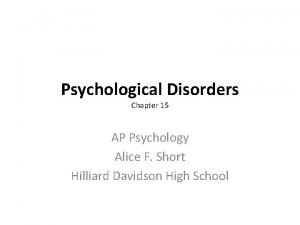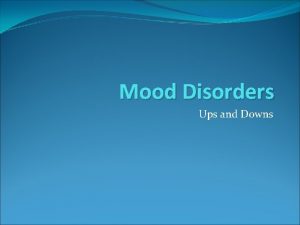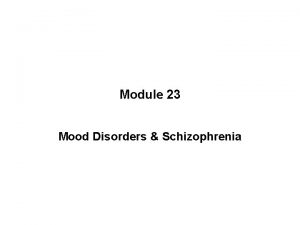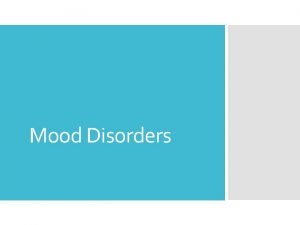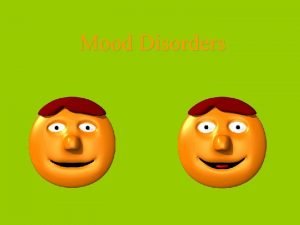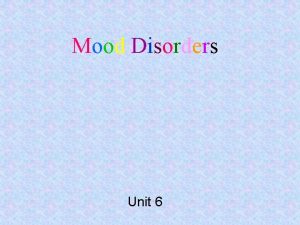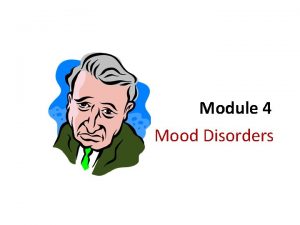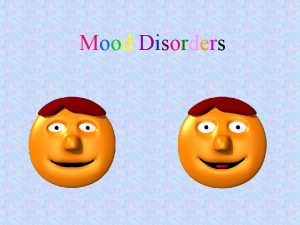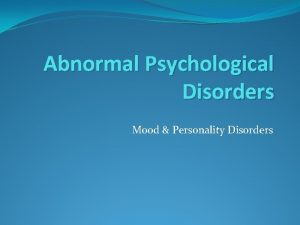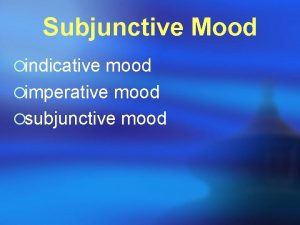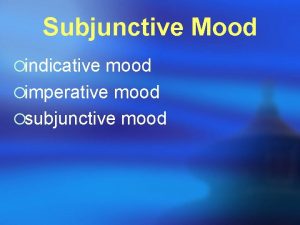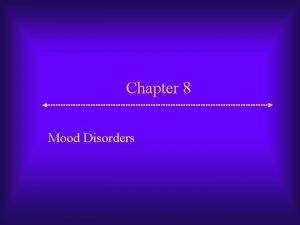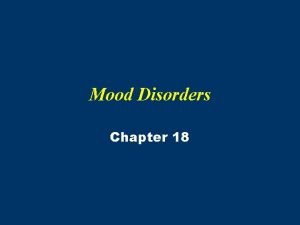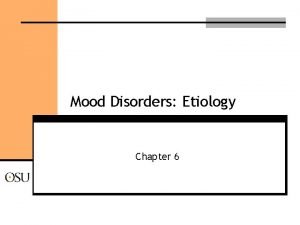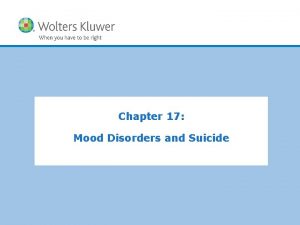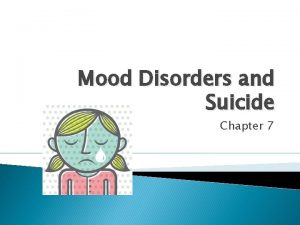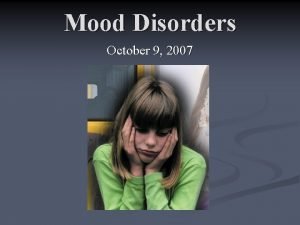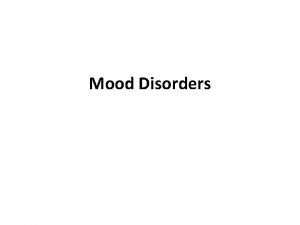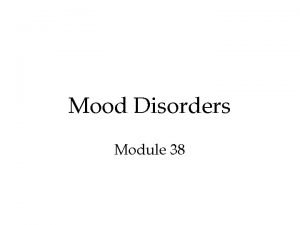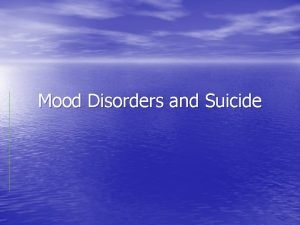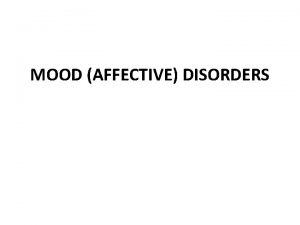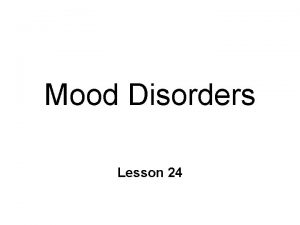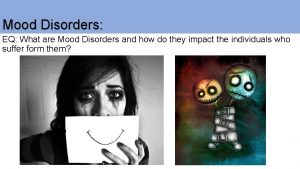Chapter 6 Mood Disorders An Overview of Mood

























- Slides: 25

Chapter 6 Mood Disorders

An Overview of Mood Disorders § Gross deviations in mood § Major depressive episodes § Manic and hypomanic episodes Types of DSM-IV-TR Depressive Disorders § Major depressive disorder § Dysthymic disorder Types of DSM-IV-TR Bipolar Disorders § Bipolar I disorder § Bipolar II disorder § Cyclothymic disorder

Major Depression: An Overview Major Depressive Episode: Overview and Defining Features § Extremely depressed mood – Lasting at least 2 weeks § Cognitive symptoms (e. g. , feeling worthless or indecisive) § Disturbed physical functioning § Anhedonia – Loss of pleasure/interest in usual activities Major Depressive Disorder § Single episode – Highly unusual § Recurrent episodes – More common

Dysthymia: An Overview and Defining Features § Milder symptoms of depression than major depression § Persists for at least 2 years § Can persist unchanged over long periods – > 20 years Facts and Statistics § Late onset – Typically in the early 20 s § Early onset – Before age 21 Greater chronicity, poorer prognosis

Bipolar I Disorder: An Overview and Defining Features § Alternating full major depressive and manic episodes Facts and Statistics § Average on onset is 18 years § Can begin in childhood § Tends to be chronic § Suicide is a common consequence

Bipolar II Disorder: An Overview and Defining Features § Alternating major depressive and hypomanic episodes Facts and Statistics § Average of onset is 22 years § Can begin in childhood § 10 to 13% of cases progress to full Bipolar I disorder § Tends to be chronic

Cyclothymic Disorder: An Overview and Defining Features § More chronic version of bipolar disorder § Manic and major depressive episodes are less severe § Manic or depressive mood states persist for long periods § Pattern must last for at least 2 years for adults § Must last at least 1 year for children and adolescents Facts and Statistics § Average of onset is about 12 or 14 years § Cyclothymia tends to be chronic and lifelong § Most are female § High risk for developing Bipolar I or II disorder

Additional Defining Criteria for Mood Disorders: Symptom Specifiers § Atypical – Oversleep, overeat, weight gain, anxiety § Melancholic – Severe depressive and somatic symptoms § Chronic – Major depression only, lasting 2 years § Catatonic – Absence of movement, very serious § Psychotic – Mood congruent hallucinations/delusions Mood incongruent features possible, but rare § Postpartum – Manic or depressive episodes after childbirth

Additional Defining Criteria for Mood Disorders: Course Specifiers § Longitudinal course Past history of mood disturbance History of recovery from depression and/or mania § Rapid cycling pattern – For Bipolar I and II disorder only § Seasonal pattern Depressive symptoms likely during a certain seasons


Mood Disorders: Additional Facts and Statistics Worldwide Lifetime Prevalence § 16. 1% for Major Depression § 3. 6% for Dysthymia § 1. 3% for Bipolar Sex Differences § Females are more likely to suffer from major depression § Difference in depression disappear at age 65 § Bipolar disorders equally affect males and females Fundamentally Similar in Children and Adults Prevalence of Depression Does not Vary Across Subcultures Relation Between Anxiety and Depression § Most depressed persons are anxious § Not all anxious persons are depressed

Mood Disorders: Familial and Genetic Influences Family Studies § Rate is high in relatives of probands § Relatives of bipolar probands – Risk for unipolar depression Adoption Studies § Data are mixed Twin Studies § Concordance rates are high in identical twins § Severe cases have a stronger genetic contribution § Heritability rates are higher for females § Vulnerability for unipolar or bipolar disorder Appear to be inherited separately

Mood Disorders: Neurobiological Influences Neurotransmitters § Serotonin and its relation with other neurotransmitters § Mood disorders are related to low levels of serotonin § The “permissive” hypothesis Stress-induced neuronal injury § For MDD and BPD Endocrine System § Elevated cortisol Sleep Disturbance § Hallmark of most mood disorders § Relation between depression and sleep

Mood Disorders: Psychological Influences (Learned Helplessness) The Learned Helplessness Theory of Depression § Related to lack of perceived control over life events Lack of positive reinforcement Depressive Attributional Style § Internal attributions Negative outcomes are one’s own fault § Stable attributions Believing future negative outcomes will be one’s fault § Global attribution Believing negative events disrupt many life activities § All three domains contribute to a sense of hopelessness

Mood Disorders: Psychological Influences (Cognitive Theory) Aaron T. Beck’s Cognitive Theory of Depression § Depressed persons engage in cognitive errors § A tendency to interpret life events negatively Types of Cognitive Errors § Arbitrary inference – Overemphasize the negative § Overgeneralization – Negatives apply to all situations Cognitive Errors and the Depressive Cognitive Triad § Think negatively about oneself § Think negatively about the world § Think negatively about the future

Beck Triad

Mood Disorders: Social and Cultural Dimensions Age § Different presentation by age Child/Adolescent – Irritability and acting out Older adults – Delusions and health concerns Class – Positive correlation with poverty Gender Imbalances § Females over males § Found in all mood disorders, except bipolar disorders § Gender imbalance likely due to socialization Social Support § Related to depression § Lack of support predicts late onset depression § Substantial support predicts recovery from depression

Integrative Model of Mood Disorders Shared Biological Vulnerability § Overactive neurobiological response to stress Exposure to Stress § Kills or injures neurons § Activates hormones that affect neurotransmitter systems § Turns on certain genes § Affects circadian rhythms § Activates dormant psychological vulnerabilities § Contributes to sense of uncontrollability § Fosters a sense of helplessness and hopelessness § Deactivation Social and Interpersonal Relationships are Moderators


Treatment of Mood Disorders: Tricyclic Medications Widely Used – Examples include Tofranil, Elavil Block Reuptake § Norepinephrine and Other Neurotransmitters Takes 2 to 8 Weeks for the Effects to be Known Negative Side Effects Are Common May be Lethal in Excessive Doses

Treatment of Mood Disorders: Selective Serotonergic Re-uptake Inhibitors (SSRIs) Specifically Block Reuptake of Serotonin § Fluoxetine (Prozac) is the most popular SSRIs Pose No Unique Risk of Suicide or Violence Negative Side Effects Are Common

Treatment of Bipolar Disorders: Lithium Is a Common Salt § Primary drug of choice for bipolar disorders § Side Effects May Be Severe § Dosage must be carefully monitored Valproic Acid - Anticonvulsant § Works in Li non-responders Other AC meds § Topiromate § Lamotragine § Tegretol

Treatment of Mood Disorders: Electroconvulsive Therapy (ECT) ECT § Involves applying brief electrical current to the brain § Results in temporary seizures § Usually 6 to 10 treatments are required ECT Is Effective for Cases of Severe Depression Side Effects Are Few and Include Short-Term Memory Loss Unclear Why ECT Works – May start up production on neuro-protective substances Relapse Following ECT Is Common

Psychological Treatment of Mood Disorders Cognitive Therapy § Addresses cognitive errors in thinking § Also includes behavioral components Behavioral Activation – Operant conditioning § Involves increased contact with reinforcing events Interpersonal Psychotherapy § Focuses on problematic interpersonal relationships Outcomes with Psychological Treatments § Are comparable to medications

Summary of Mood Disorders All Mood Disorders Share § Gross deviations in mood § Unipolar or bipolar deviations in mood § Common biological and psychological vulnerability Occur in Children, Adults, and the Elderly Onset, Maintenance, and Treatment are affected by § Stress § Social Support Suicide Is an Increasing Problem § Not Unique to Mood Disorders Medications and Psychotherapy Produce Similar Results Relapse Rates for Mood Disorders Are High
 Mood disorders dsm 5
Mood disorders dsm 5 Chapter 18 psychological disorders
Chapter 18 psychological disorders Chorionic villus
Chorionic villus Chapter 8 skin disorders and diseases
Chapter 8 skin disorders and diseases Chapter 6 musculoskeletal system
Chapter 6 musculoskeletal system Chapter 46 digestive and endocrine disorders
Chapter 46 digestive and endocrine disorders Types of somatic disorder
Types of somatic disorder Chapter 29 endocrine and metabolic disorders
Chapter 29 endocrine and metabolic disorders Chapter 21 mental health diseases and disorders
Chapter 21 mental health diseases and disorders Chapter 18 psychological disorders
Chapter 18 psychological disorders Chapter 18 eating and feeding disorders
Chapter 18 eating and feeding disorders Chapter 17 reproductive system diseases and disorders
Chapter 17 reproductive system diseases and disorders Chapter 15 nervous system diseases and disorders
Chapter 15 nervous system diseases and disorders Chapter 15 anxiety and obsessive-compulsive disorders
Chapter 15 anxiety and obsessive-compulsive disorders Chapter 14 psychological disorders
Chapter 14 psychological disorders Chapter 14 depressive disorders
Chapter 14 depressive disorders Chapter 11 childhood and neurodevelopmental disorders
Chapter 11 childhood and neurodevelopmental disorders Glencoe health chapter 5 vocabulary
Glencoe health chapter 5 vocabulary Elsevier
Elsevier Chapter 5 lesson 4 getting help
Chapter 5 lesson 4 getting help Onychophagy nail disorder
Onychophagy nail disorder What conditions do fungal organisms favor for growth
What conditions do fungal organisms favor for growth Cardiovascular system diseases and disorders chapter 8
Cardiovascular system diseases and disorders chapter 8 Milady chapter 8 skin disorders and diseases
Milady chapter 8 skin disorders and diseases Chapter 14 psychological disorders
Chapter 14 psychological disorders Ap psychology chapter 15 psychological disorders
Ap psychology chapter 15 psychological disorders
